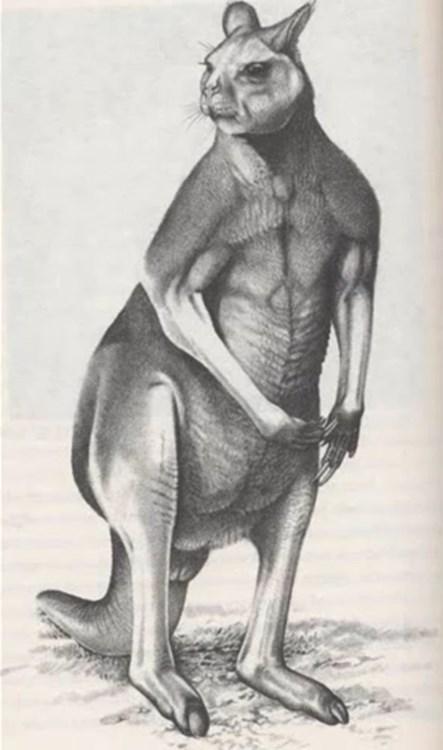
3 minute read
Australia
The Lost Megafauna of Australia
by Kimber Ray Imagine living in a perilous environment, filled with one -ton lizards, marsupial lions, and 9 foot tall kangaroos. Over 40,000 years ago, this was the reality in Australia, which was once dominated by giant vertebrates known as megafauna (elephants and grizzly bears would be examples of modern megafauna). Today, however, all of these megafauna are long extinct, and the debate on how this occurred seems to be moving towards a surprising, though unwelcomed, conclusion: human hunting triggered a mass extinction that drastically and permanently altered the future landscape of Australia. The debate on what caused the extinction of Australia’s megafauna has dragged on for nearly half a century. According to Dr. John Alroy, a biological researcher in Australia, this is in part because “…the idea that Stone Age hunters could cause such utter havoc across three entire continents over very short time spans strikes many people as incredible. Like it or not, though, it's the truth, and it's time for us to all confront it.” One theory that remained popular for quite some time in explaining the extinction of Australia’s megafauna was the idea that climate change caused the landscape to shift and the megafauna were unable to adapt. This theory, however, was often criticized for failing to account for how the megafauna had previously been able to comfortably survive two million years of climate oscillations. What’s more, humans are estimated to have arrived at Australia around 41,000 years ago—a time when climate change was relatively minimal. Only a thousand years later—40,000 years ago—the majority of Australia’s megafauna was extinct. The extinction of Australia’s megafauna was accompanied by drastic changes to the landscape and ecology of Australia. Once a lush rainforest, many of Australia’s ancient giants were in fact herbivores who fed on the leaves and debris, thus mitigating the risk of forest fires. Today, Australia is covered in vast expanses of desert and grasslands. So the question for scientists was this: did the extinction of the megafauna—who consumed forest fire fuel— lead to forest fires that changed the landscape, or did climate change alter the landscape, reducing critical food supplies, and leading to the extinction of the megafauna?
Recent studies by a team of paleontologists have now found the evidence needed to support the conclusion that it was the arrival of humans, rather than climate change, that caused the extinction of Australia’s megafauna. Through analysis of ancient spores and charcoal, they determined that changes to the landscape occurred after the extinction of the megafauna, suggesting that changes to the landscape were the result of extinction rather than the cause of it. Thus, dwindling numbers of megafauna resulted in more forest fires, which destroyed the food and habitat of the megafauna, resulting in a deadly cycle that ended in the extinction of these strange creatures. While it seems like a shock to imagine that humans with such limited technology could have had such a powerful impact on the landscape that we see today, this idea is nothing new and has been demonstrated in many other regions of the world. In the book Changes in the Land by William Cronon, he explains that we have early colonists to blame for the bitter cold winters and humid summers of New Jersey. By removing massive amounts of trees from the landscape, winter winds penetrated deeper and there were fewer plant roots to absorb water, resulting in a swampier land and more humid summers. While Australia’s lost megafauna may be the first record of humans causing major changes to the functioning of ecosystems, it was certainly far from the last. As we learn more about how we influence the environment, it is becoming increasingly clear that we are, have been, and continue to be, a critical component of the ecosystem. By doubting the capability of humans to exert such forceful and permanent effects on our environment, what is at stake is more than just a basic understanding of the world—it is our own place in the world that is at stake. From the past to the present, we can see that we are responsible for our future—we must learn to not endanger it.
References:
Alroy, J. “Australia’s megafauna extinctions: cause and effect.” Australiasian Science Magazine. May 2012. Web: < http:// www.australasianscience.com.au/article/issue-may-2012/australiasmegafauna-extinctions-cause-and-effect.html>
Diamond, J. Guns, Germs, and Steel: The Fates of Human Societies. W.W. Norton & Company: NY. 1999.
Rule, S. et al. “The aftermath of megafaunal extinction: ecosystem transformation in Pleistocene Australia.” Science vol. 335, p. 1483. March 2012. Web: <http://211.144.68.84:9998/91keshi/Public/File/41/335-6075/ pdf/1483.full.pdf>
Image screenshot from: www.youtube.com/watch?v=c6QpByKoeHw
Procoptodon goliah—Australia’s extinct 9-foot kangaroo











